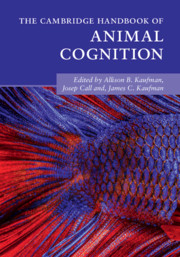Book contents
- The Cambridge Handbook of Animal Cognition
- The Cambridge Handbook of Animal Cognition
- Copyright page
- Dedication
- Contents
- Figures, Tables, and Boxes
- Contributors
- Acknowledgments
- Introduction
- Part I Communication and Language
- Part II Memory and Recall
- Part III Social Cognition
- Part IV Social Learning and Teaching
- Part V Numerical and Quantitative Abilities
- 24 Numerical and Quantitative Abilities Overview
- 25 Numerical Competence in Fish
- 26 Spatial–Numerical Association in Nonhuman Animals
- 27 Perceptual Categorization in Pigeons
- Part VI Innovation and Problem-Solving
- Index
- References
27 - Perceptual Categorization in Pigeons
from Part V - Numerical and Quantitative Abilities
Published online by Cambridge University Press: 01 July 2021
- The Cambridge Handbook of Animal Cognition
- The Cambridge Handbook of Animal Cognition
- Copyright page
- Dedication
- Contents
- Figures, Tables, and Boxes
- Contributors
- Acknowledgments
- Introduction
- Part I Communication and Language
- Part II Memory and Recall
- Part III Social Cognition
- Part IV Social Learning and Teaching
- Part V Numerical and Quantitative Abilities
- 24 Numerical and Quantitative Abilities Overview
- 25 Numerical Competence in Fish
- 26 Spatial–Numerical Association in Nonhuman Animals
- 27 Perceptual Categorization in Pigeons
- Part VI Innovation and Problem-Solving
- Index
- References
Summary
This chapter reviews research on visual categorization in pigeons including (1) basic-level categories, members of which are perceptually similar to each other (e.g., car or chair), (2) subordinate-level categories representing a subclass of a basic level category (e.g.,office chair or sports car), and (3) superordinate-level categories comprising several basic-level categories (e.g., furniture or vehicle).Current research convincingly demonstrates pigeons’ ability to form these categories. Moreover, pigeons’ basic-level categories appear to be similar to those of humans. However, the extent of similarity between superordinate-level and subordinate-level categories in pigeons and humans is not yet clear.
- Type
- Chapter
- Information
- The Cambridge Handbook of Animal Cognition , pp. 621 - 636Publisher: Cambridge University PressPrint publication year: 2021



